Ingrown Hair with Black Spot: Symptoms, Treatment, and Prevention Guide
What causes ingrown hairs with black spots. How to identify the symptoms of ingrown hairs. What are the most effective treatments for ingrown hairs. How to prevent ingrown hairs and associated hyperpigmentation.
Understanding Ingrown Hairs: Causes and Risk Factors
Ingrown hairs occur when hair becomes trapped within the skin, leading to inflammation and potential infection. While they can happen naturally, they’re often the result of trauma to the hair follicle. With approximately 5 million hair follicles on the human body, the likelihood of experiencing an ingrown hair is relatively high.
Common causes of ingrown hairs include:
- Shaving: This process stretches the hair and creates a sharp edge, which can cause the hair to grow back into the skin.
- Plucking or Waxing: These hair removal methods can disrupt the natural growth path of the hair within the follicle.
- Impactions: A buildup of dead skin cells can block the follicle, causing the hair to grow sideways.
- Hair Type: Thick or curly hair is more prone to ingrown hairs as it tends to curl back or grow sideways in the follicle.
Are certain individuals more susceptible to ingrown hairs? Both men and women can experience ingrown hairs, particularly on the face, neck, and bikini line. Those with thicker or curlier hair types are at a higher risk due to the natural tendency of their hair to curl back into the skin.

Recognizing the Symptoms of Ingrown Hairs
Identifying an ingrown hair is crucial for proper treatment. The primary symptoms include:
- Small, round, solid bumps (papules)
- Painful, tender spots
- Itching or irritation
- Redness around the affected area
- Visible hair beneath the skin’s surface
- Small pustules (pus-filled bumps)
Why do ingrown hairs often appear with a black spot? The black spot is typically the trapped hair visible beneath the skin’s surface. In some cases, it may also be a sign of post-inflammatory hyperpigmentation, which occurs as a result of the skin’s protective response to inflammation.
The Link Between Ingrown Hairs and Hyperpigmentation
Ingrown hairs frequently lead to hyperpigmentation, particularly in individuals with darker skin tones. This occurs due to the inflammation and potential bacterial presence in the affected follicle, triggering the skin’s protective response.
How does this process work? When the skin experiences inflammation or trauma, it increases melanin production as a protective measure. This excess melanin leads to the formation of dark spots, known as post-inflammatory hyperpigmentation.
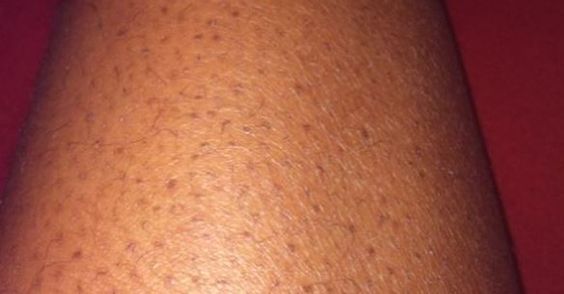
Can hyperpigmentation from ingrown hairs be prevented? While it’s challenging to completely prevent hyperpigmentation, minimizing inflammation and treating ingrown hairs promptly can significantly reduce the risk of developing dark spots.
Effective Treatment Strategies for Ingrown Hairs
Treating ingrown hairs requires a gentle, systematic approach to minimize further irritation and prevent infection. Here’s a step-by-step guide:
- Apply a warm compress to the affected area to soothe inflammation and encourage the hair to surface.
- Once the hair emerges, use sterile tweezers to gently lift it above the skin’s surface. Avoid plucking or breaking the skin to prevent bacterial introduction.
- Keep the area clean and gently exfoliated to kill bacteria and maintain open follicles. Consider using a micro-exfoliating, anti-microbial wash containing mandelic acid.
- Apply a benzoyl peroxide gel to flush the follicle, eliminate bacteria, and promote healing.
- Use soothing products containing allantoin or aloe vera to calm redness and irritation.
Is it safe to continue hair removal in the affected area? It’s crucial to avoid further hair removal until the ingrown hair has fully healed. Continuing to shave or wax can exacerbate the condition and increase the risk of infection.

Preventing Ingrown Hairs: Best Practices and Techniques
Prevention is key when it comes to ingrown hairs. Here are some effective strategies to minimize their occurrence:
- Exfoliate regularly, especially before hair removal, using products containing mandelic acid, salicylic acid, or glycolic acid.
- Use a vitamin A or mandelic acid serum to accelerate cell turnover and prevent follicle blockages.
- When shaving, follow the direction of hair growth and avoid going over the same area multiple times.
- Keep skin well-moisturized and use appropriate shaving products.
- Consider using an electric razor on a higher setting to avoid cutting hair too close to the skin.
How often should one exfoliate to prevent ingrown hairs? While individual needs may vary, exfoliating 2-3 times a week is generally sufficient for most people. Those with sensitive skin may need to exfoliate less frequently.
Addressing Hyperpigmentation from Ingrown Hairs
Dealing with the dark marks left behind by ingrown hairs requires patience and consistent skincare. Here are some effective methods:
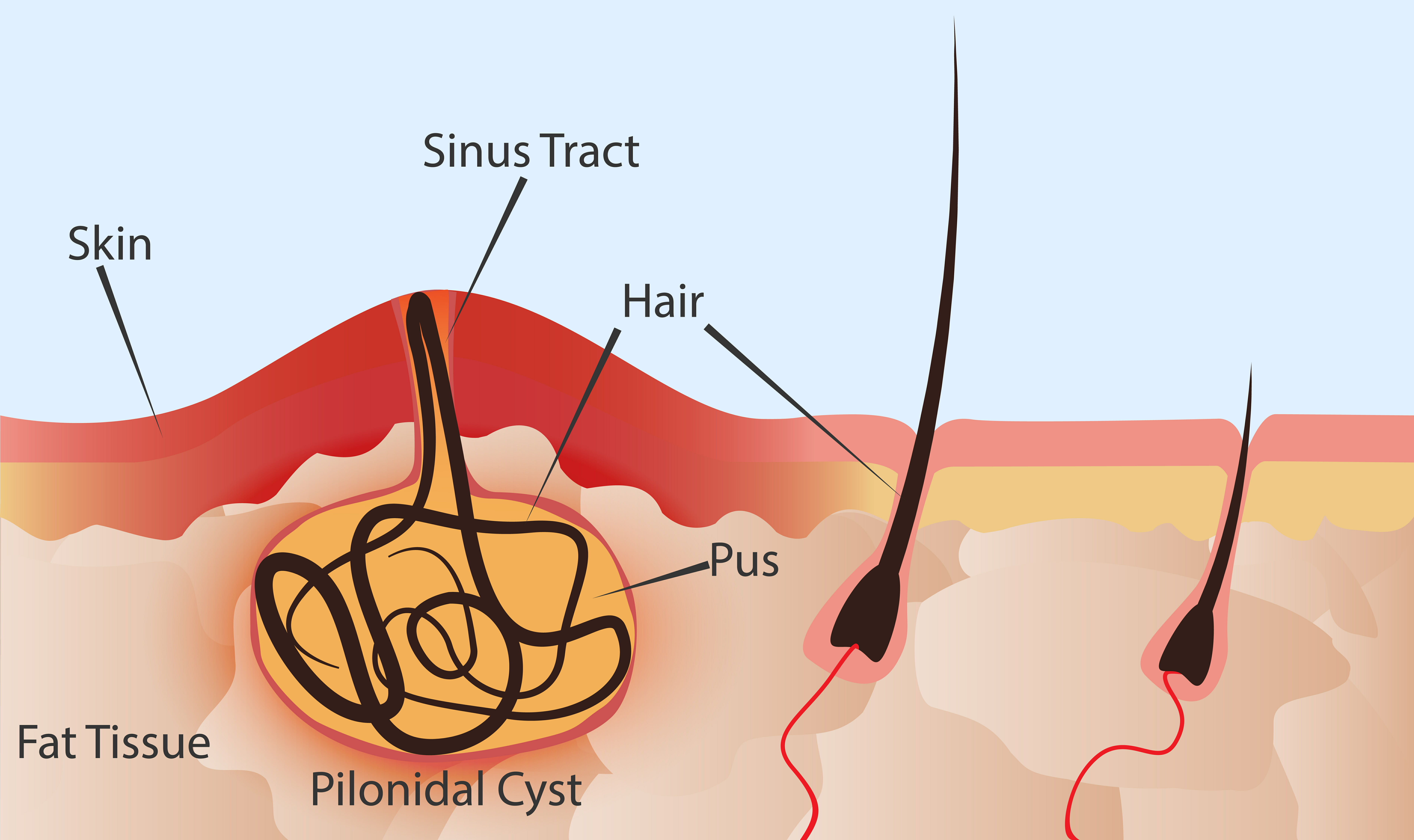
- Use products that accelerate cell turnover, such as those containing vitamin A, mandelic acid, lactic acid, or glycolic acid.
- Incorporate brightening ingredients like vitamin C, kojic acid, or hydroquinone into your skincare routine.
- Consider using products that combine exfoliating and brightening properties, such as mandelic acid or glycolic acid.
- Apply sunscreen daily to protect against UV rays, which can worsen hyperpigmentation.
How long does it take for hyperpigmentation to fade? The timeline for fading hyperpigmentation can vary depending on the individual’s skin type, the severity of the discoloration, and the treatment methods used. Generally, it can take several weeks to months for noticeable improvement.
Advanced Treatments for Persistent Ingrown Hairs
For those dealing with chronic or severe ingrown hairs, more advanced treatments may be necessary. These can include:
- Laser Hair Removal: This method can reduce hair growth and minimize the risk of ingrown hairs.
- Chemical Peels: Professional-grade peels can help exfoliate the skin more deeply and address hyperpigmentation.
- Topical Retinoids: Prescription-strength retinoids can accelerate cell turnover and prevent follicle blockages.
- Oral Antibiotics: In cases of severe inflammation or infection, a dermatologist may prescribe oral antibiotics.
When should one consider professional treatment for ingrown hairs? If home remedies and over-the-counter treatments aren’t effective, or if you’re experiencing frequent, painful ingrown hairs, it’s advisable to consult a dermatologist for personalized treatment options.

The Role of Diet and Lifestyle in Managing Ingrown Hairs
While often overlooked, diet and lifestyle factors can play a significant role in skin health and the prevention of ingrown hairs. Consider the following:
- Hydration: Drinking adequate water helps maintain skin elasticity and promotes healthy hair growth.
- Balanced Diet: Consuming a diet rich in vitamins A, C, and E can support skin health and reduce inflammation.
- Stress Management: High stress levels can impact hormone balance, potentially affecting hair growth patterns.
- Regular Exercise: Improved circulation from exercise can promote healthier skin and hair growth.
Can certain foods help prevent ingrown hairs? While no specific food can prevent ingrown hairs entirely, a diet rich in anti-inflammatory foods like fatty fish, leafy greens, and berries may help reduce overall skin inflammation and promote healthier hair growth.
Choosing the Right Products for Ingrown Hair Prevention and Treatment
Selecting appropriate skincare and hair removal products is crucial in managing and preventing ingrown hairs. Consider the following recommendations:

- Cleansers: Opt for gentle, non-comedogenic cleansers that won’t clog pores.
- Exfoliants: Look for products containing salicylic acid, glycolic acid, or mandelic acid for effective yet gentle exfoliation.
- Moisturizers: Choose non-greasy, hydrating formulas to keep skin supple and reduce friction during hair removal.
- Shaving Products: Use lubricating shaving creams or gels to minimize irritation.
- Post-Hair Removal Care: Apply soothing, antibacterial products after hair removal to prevent inflammation and infection.
Are natural remedies effective for treating ingrown hairs? While some natural remedies like tea tree oil or aloe vera may have soothing properties, their effectiveness can vary. It’s generally more reliable to use clinically tested products specifically formulated for treating ingrown hairs.
The Impact of Different Hair Removal Methods on Ingrown Hair Risk
Different hair removal methods carry varying risks of causing ingrown hairs. Understanding these can help you make informed choices:

- Shaving: High risk, especially with multi-blade razors that cut hair below skin level.
- Waxing: Moderate risk, as it can sometimes break hair off below the skin surface.
- Epilating: Similar risk to waxing, as it pulls hair out from the root.
- Hair Removal Creams: Lower risk, as they dissolve hair at the surface level.
- Laser Hair Removal: Initially may cause some ingrown hairs, but long-term can reduce their occurrence.
Which hair removal method is best for preventing ingrown hairs? For those prone to ingrown hairs, hair removal creams or professional laser hair removal may be the safest options. However, individual results can vary, and it’s important to find a method that works best for your skin and hair type.
How to Deal with Ingrown Hairs and the Dark Spots They Leave Behind – Vivant Skin Care
How to Deal with Ingrown Hairs and the Dark Spots They Leave Behind – Vivant Skin Care
The Regimen
‹ Back to Blog
With about 5 million hair follicles on the surface of your skin, the odds of getting an ingrown hair at some point are fairly high. They’re itchy, painful, and they often leave behind dark marks as a not-so-subtle warning that you haven’t seen the last of them. The worst part? All your efforts to keep your skin velvet smooth also happen to be the surest ways of triggering one of these sore, tender bumps. To avoid the dreaded ingrown hair and the marks they leave behind, here’s everything you need to know.
WHAT CAUSES INGROWN HAIRS
Ingrown hairs result from hair becoming trapped within the skin, leading to inflammation and sometimes infection. It can happen organically, but it’s usually the result of trauma to the follicle.
Shaving
Shaving stretches the hair beyond the follicle and then creates a sharp edge on the hair. The hair snaps back beneath the surface of the skin, and that new, fresh edge can get snagged instead of growing correctly out of the pore.
Plucking or Waxing
All hair removal processes can cause trouble by disrupting the hair’s natural growth path within the follicle.
Impactions
A buildup of dead skin cells can also contribute to ingrown hairs as the follicle can become blocked, causing the hair to grow sideways.
Hair Type
Both men and women are candidates for ingrown hairs (they can appear on the face, neck,or the bikini line). It’s more common with thick or curly hair, which tends to curl back or grow sideways in the hair follicle.
HOW DOES AN INGROWN HAIR CAUSE HYPERPIGMENTATION?
Ingrown hairs are often accompanied by bacteria and inflammation in the follicle, which causes the skin to mobilize a protective response in the form of increased melanin. The dark spots that appear are known as post-inflammatory hyperpigmentation.
The dark spots that appear are known as post-inflammatory hyperpigmentation.
HOW TO TREAT AN INGROWN HAIR
1. Apply a warm compress to soothe and reduce inflammation.
2. Once the hair emerges above the skin, use sterile tweezers to gently lift it just enough to release it from under the skin. Do not pluck it out, and don’t poke or break the skin. This is likely to introduce bacteria, further inflame the bump, and increase the chances of post-inflammatory hyperpigmentation.
3. Keep the area cleansed and gently exfoliated to kill bacteria and keep the follicle open. Vivant’s micro-exfoliating and anti-microbial Mandelic Acid 3-In-1 Wash is an excellent choice.
4. Apply a benzoyl peroxide gel like Vivant’s BP 10% Gel Medication to flush the follicle, kill bacteria, and speed healing.
5. To soothe redness and irritation, you can apply Allantoin Sedating and Hydrating Lotion or Totaloe Calming and Hydrating Gel.
Don’t continue to shave or remove hair in the affected region. This is “one of the worst things you can do,” says Nada Elbuluk, MD, MSc, assistant professor in the Ronald O. Perelman Department of Dermatology at NYU Langone Medical Center. “Wait until razor bumps have resolved before going back to shaving or engaging in further hair removal at the site.”
This is “one of the worst things you can do,” says Nada Elbuluk, MD, MSc, assistant professor in the Ronald O. Perelman Department of Dermatology at NYU Langone Medical Center. “Wait until razor bumps have resolved before going back to shaving or engaging in further hair removal at the site.”
HOW TO AVOID INGROWN HAIRS
Exfoliate regularly, and especially before shaving, with ingredients like mandelic acid, salicylic acid, and glycolic acid to keep the follicles clear of impactions.
Use a vitamin A or mandelic acid serum to accelerate cell turnover and keep dead skin cells from clogging follicles and creating impactions.
When shaving, follow the direction of the hair growth and avoid shaving too close to the skin or going over the same area multiple times. Don’t pull the skin taut while shaving.
Make sure the skin is wet before shaving, and use a moisturizing shaving cream, gel, or foam while shaving. Vivant’s Mandelic Acid 3-In-1 Wash or Green Tea Antioxidant Cleanser are good choices
Using an electric razor and avoiding the closest shave setting will reduce the chances of getting an ingrown hair.
HOW TO GET RID OF THE DARK MARKS LEFT BEHIND BY INGROWN HAIRS
Use products that accelerate cell turnover to help disperse pigment from the skin’s surface. Vitamin A, mandelic acid, lactic acid, and glycolic acid are good choices.
Pair these with brightening ingredients like vitamin C, kojic acid, or hydroquinone.
Mandelic acid and glycolic acid are both exfoliators and brighteners.
Wear sunscreen daily to protect against UV, which will worsen the dark marks.
RECOMMENDED PRODUCTS
Mandelic Acid 3-In-1 Wash
Gentle exfoliating and brightening cleanser with antibacterial and anti-inflammatory properties.
Daily Repair Pads
Mandelic acid, salicylic acid, niacinamide, and healing zinc decongest pores, remove surface debris, and help disperse pigment, leaving skin smooth, hydrated, and ready to drink in your favorite serum.
8% Mandelic Acid 3-In-1 Serum
A brightening, antibacterial, micro-exfoliating serum clear, healthy follicles and radiant skin.
Derm-A-Gel
Accelerate cell renewal to fade pigment, decongest follicles, and promote smooth, even tone.
Pure C + E
A daily booster for advanced photoprotection, brightening, and cellular repair. Formulated for purity and potency.
BP 10% Gel Medication
Concentrated antibacterial medication to peel impactions from the follicle and speed healing.
Day Treatment Lotion SPF 15
Daily foundational sunscreen to protect against UV damage. Lightweight, non-greasy, non-comedogenic.
Read about why dark spots get darker before they get lighter.
Tagged
bikini line,
ingrown hairs,
and
shaving
← Previous
Next →
Related Articles
What does brightening really mean?
Four Ways You’re Triggering Hyperpigmentation and How to Stop
Subscribe to get our latest newsletter on email
Welcome to Vivant
Subscribe to our mailing list for expert advice and skin care tips, get entitled to win a Skin Fitness System valued at $160.
or
Continue
Did you know you that when you buy a complete regimen you get 10% off?
Continue
★ Judge.me Reviews
How to Get Rid of Ingrown Hair Scars – Bushbalm
Share:
Twitter
Facebook
Pinterest
/en-de/blogs/dark-spots/how-to-get-rid-of-ingrown-hair-scars
Apr 10, 2022 Posted by: David Gaylord
Share:
Twitter
Facebook
Pinterest
/en-de/blogs/dark-spots/how-to-get-rid-of-ingrown-hair-scars
Getting discolouration and scarring from ingrown hairs is very common. As an ingrown hair heals the skin is irritated and the pigment often never recovers. Below you’ll find the routine to get rid of ingrown hair scarring.
As an ingrown hair heals the skin is irritated and the pigment often never recovers. Below you’ll find the routine to get rid of ingrown hair scarring.
Do ingrown hairs leave scars?
Yes. Just like any irritation to the skin there is a chance you can get a scar. Ingrown hairs often lead to redness and irritation, which can lead to what are often referred to as ‘dark spots’.
Where are ingrown hairs most common?
Depending on your hair growth you can get ingrown hairs in many locations. Some of the most common in men are on the neckline and women commonly get ingrown hairs on their bikini line.
Most common places for ingrown hairs:
- pubic area
- neckline
- back of neck
- nipple hair
Can I get laser to remove ingrown hair scars?
Yes. Using laser treatment on scaring is very common. However, we recommend seeing your doctor or trying more natural treatments and products prior to going with laser treatment. We recommend reading the article by the AAD on questions you should ask before using laser.
We recommend reading the article by the AAD on questions you should ask before using laser.
Getting rid of ingrown hair scars on your pubic area
To clear up dark spots and ingrown hair scars on your pubic region we recommend a two types of products.
- A dark spot oil high in vitamin c
- A surface exfoliant high in vitamin c
Focusing on vitamin c is critical to lighten dark spots and scarring of ingrown hairs, specifically on your pubic area. Since your bikini and pubic region is more sensitive than most areas we recommend looking for products that use natural or naturally derived ingredients.
“Bermuda Dark SpotOil is a 100% natural and vegan skincare product that helps reduce the look of discoloration and dark spots found anywhere on the body. With a hint of lemon essential oil, Bermuda has a soft refreshing scent that will make you feel like you are in paradise.”
Ingrown Hair Photos on your Inner Thighs
What is post inflammatory hyperpigmentation?
Post inflammatory hyperpigmentation is when skin cells are damaged and react by making additional melanin.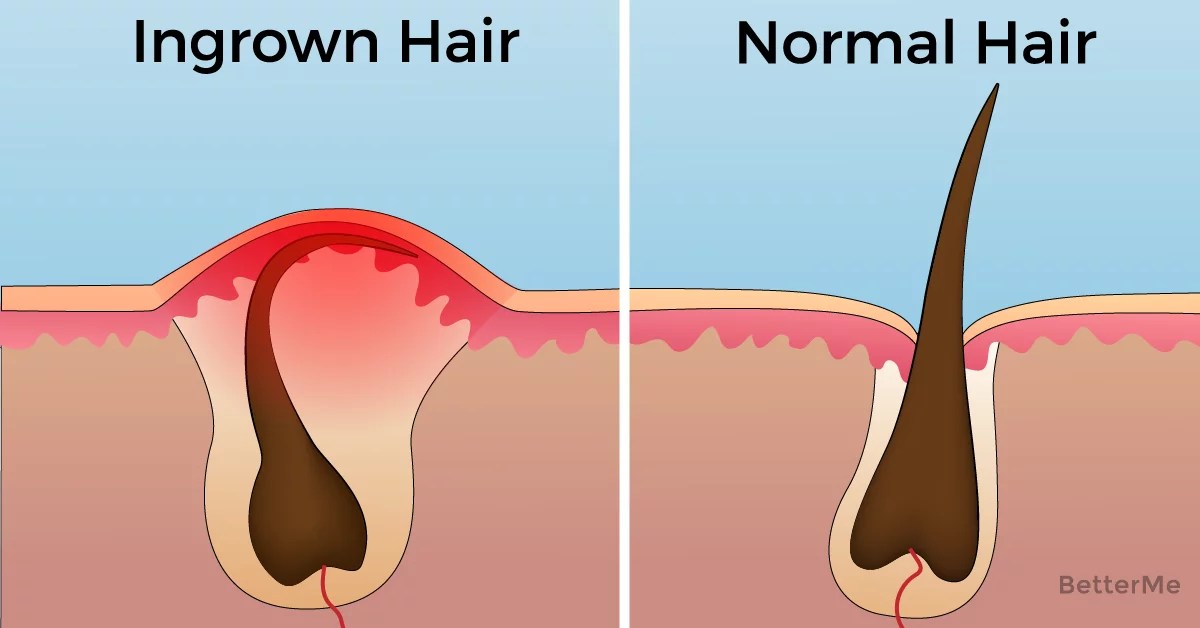 Generally this type of hyperpigmentation shows up on tan or brown skin.
Generally this type of hyperpigmentation shows up on tan or brown skin.
“I am a Black woman and it has evened my skin so much to the point that my confidence has increased! I use it on my face, private area and my armpits. I’m so excited for swimsuit season and can’t stop looking in the mirror. ” – Dark Spot Oil Customer
If you have curly, coiled hair you are more receptive to ingrown hairs, which typically lead to this type of hyperpigmentation.
Tips to Prevent Ingrown Hair Scarring
There are several ways to prevent scarring from ingrown hairs, which are non-intrusive.
Laser Hair Removal
One way to prevent ingrown hairs is to reduce the amount of hairs that need to grow back. Laser hair removal, although a more costly option, does have this effect on the skin and hair.
Exfoliating your Bikini Line
By exfoliating regularly you’ll soften the skin and hair follicles helping the curly or coiled hair grow back through the skin appropriately. Use a physical exfoliant to soften scar tissues, reduce razor bumps and prevent ingrown hairs.
Use a physical exfoliant to soften scar tissues, reduce razor bumps and prevent ingrown hairs.
Moisturizing your Pubic Area Regularly
Using a moisturizing shaving cream, as well as pubic hair oil will help soften the skin and hair. You always want to soften the skin on your pubic region to prevent ingrown hairs.
Are you more likely to get ingrown hair scarring?
Those who get the most ingrown hairs are more likely to get scarring from them. However, if you have a skin tone that is more prone to dark spots or scarring you’re also at a disadvantage. By focusing on preventing ingrown hairs entirely you’ll reduce the chance of getting hyperpigmentation, which is what we recommend.
ChevronSimple chevron pointing left
Previous article
ChevronSimple chevron pointing left
Previous
Acanthosis Nigricans PicturesNext article ChevronSimple chevron pointing right
Next ChevronSimple chevron pointing right
What is a Glycolic Acid and will it lighten your armpits?
About the Author
David Gaylord
CEO and co-founder of Bushbalm Skincare. As someone who suffers from chronic eczema he’s become a solutions based skincare advocate.
As someone who suffers from chronic eczema he’s become a solutions based skincare advocate.
Ingrown hair: how to remove / get rid of, what to do, why ingrown hairs
We asked experts why hairs grow in, how to get rid of them and what to do for prevention.
Our experts:
- Irina Zhurina – master of the Wax & Go salon chain
- Kristina Schlega – cosmetologist at the LazerJazz clinic
- Subcutaneous (they are also called pantyhose ) (No. 1 in the picture) – more often appear on the legs from tight clothes (jeans and tights). The hair grows into the surface layer of the skin and grows along. Often it even shines through the skin, and it is not clear that it has grown at all.
- Superficial ingrown hairs (piercing) (#4 in the picture) are hairs that have grown but have re-embedded into the skin. The reasons are tight clothing or deformation of the hair itself.
- Twisted (#2 in the picture) is similar to subcutaneous, but the hair is twisted in one place and continues to grow under the skin, not out. Sometimes this leads to inflammation.
- Follicular (growing inward) (No. 3 in the picture) are the most dangerous, inflammation often forms around them, the hair in this case can block the path to the sebaceous ducts, provoking the development of inflammation and the accumulation of bacteria.
 It looks like a big pimple or boil. As a rule, it occurs in owners of thick, dense skin.
It looks like a big pimple or boil. As a rule, it occurs in owners of thick, dense skin. - Use body exfoliators – soft scrubs, enzyme powders, delicate exfoliating washcloths. Ideal – 2 times a week. If more often, the skin will begin to thicken and this will only aggravate the situation. If less, there will be no effect.
- Supracor Stimulite washcloth
- Pomegranate body scrub, Lycon
- Tea-Tree shower gel, Lycon — contains 2% tea tree essential oil and has a bactericidal effect, protects follicles from inflammation after depilation.

- For Your Sugar Body Scrub
- Use moisturizing products – it is easier for hairs to grow through moisturized elastic skin.
- Use anti-ingrown products – use 2 times a day – in the morning and in the evening – until the ingrown hair appears on the surface. Then twice a week – for prevention.
- Aravia Enzyme Powder – designed to prepare the skin for depilation
- Cream Ingrown-X-It Solution, Lycon – spot treatment and for delicate areas
- Serum-spray Ingrown-X-It Solution, Lycon with a complex of lactic and salicylic acids
- Anti-ingrown hair cream Kerapil, Noreva
- Paste against ingrown hairs White line, Italwax
- Best Body Cleansers 2020
- Best Body Cleansers 2019
90 017
What are the causes of ingrown hairs?
Root cause improper hair removal , in which the hair breaks off or part of the follicle remains under the skin.
This is what happens when the wrong shave against hair growth and on dry skin. Less often – after incorrectly performed depilation with wax, sugar, an electric epilator or tweezers.
Another reason is thick superficial layer of skin . Horny scales are layered and do not allow the growing hair to break out. Thickening of the epidermis often occurs due to overdrying of the skin with aggressive surfactants and scrubs, as well as for certain diseases (for example, diabetes or hypothyroidism).
Thickening of the epidermis often occurs due to overdrying of the skin with aggressive surfactants and scrubs, as well as for certain diseases (for example, diabetes or hypothyroidism).
Tight underwear , tights, tight jeans rub mechanically, from which the skin is protected and thickened.
Sunburn can also be the cause – the skin dries out, and it is more difficult for the hairs to penetrate the stratum corneum.
Hereditary factors may also affect . For example: when the follicle is located under the skin at an acute angle . African Americans, Caucasians, and Hispanics are more likely to suffer from ingrown hairs—thick, coarse, frizzy hair can fold under the skin on its own.
May affect taking hormonal drugs .
Irina Zhurina : Hormonal medicines change the general condition of the body – the hair can change its structure, the skin can become dry or oily. After treatment, everything returns to normal.
After treatment, everything returns to normal.
Hair does not grow back after laser hair removal – the laser destroys the hair completely, along with the follicle.
I wax at the salon and often get ingrown hairs. Is the master doing something wrong?
Irina Zhurina : Optional. This could be due to any of the above reasons. Although it happens that the master does not follow the technique – or you go to different masters. They can be good and do everything according to the rules, but everyone’s hands are different – they cannot remove hairs in exactly the same way. It turns out that once the hair was removed at one angle, the second time at a slightly different angle, the third time at the third. It is better to go to one master.
How do you know if it’s an ingrown hair and not a wart, pimple or herpes?
Kristina Schlega : First, the location: in women, hair usually grows in the bikini area and on the legs, in men – on the face. Next, we look at the formation itself: usually, an ingrown hair looks like a reddish spherical seal with a visible dark hair inside.
Next, we look at the formation itself: usually, an ingrown hair looks like a reddish spherical seal with a visible dark hair inside.
Ingrown hairs may look like pimples. Note the moment when the seal appeared. Ingrown hairs appear within a day after shaving or other depilation method.
Herpes is accompanied by severe discomfort: pain and burning. Bubbles with a clear liquid appear on the reddened skin.
Warts look like flat patches of skin color. Sometimes they go by themselves without a trace.
Why does an ingrown hair leave a dark spot? And what to do with it?
Dark spots are post-acne hyperpigmentation. They appear when inflammation appears at the site of an ingrown hair, or the skin has been cut open to remove it.
Serums with acids for lightening can be applied pointwise to the pigment spot – or special products against ingrown hairs can be used. As a rule, they contain the same clarifying components – fruit acids, vitamin C.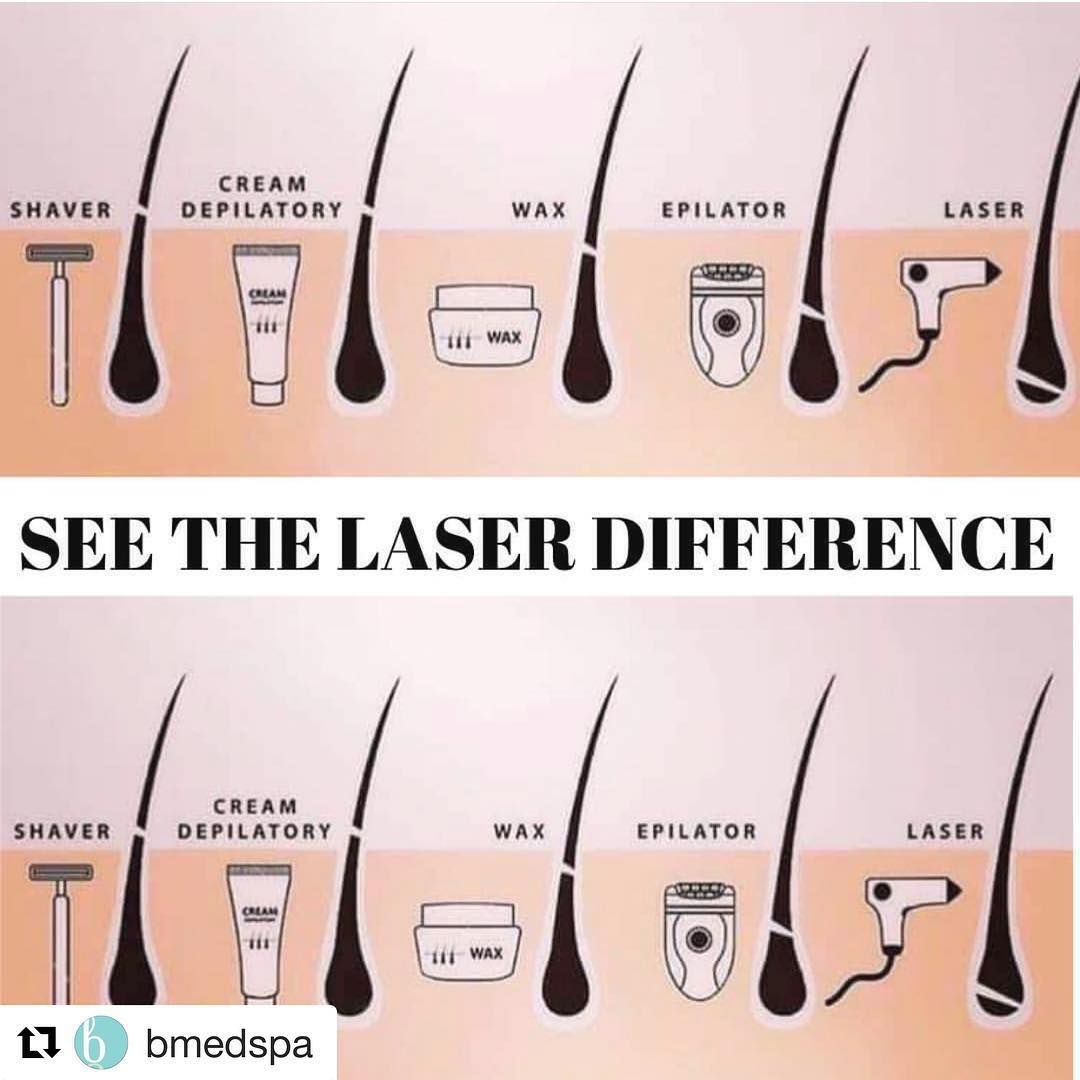
Are there different types of ingrown hairs? How to remove them?
There are four types of ingrown hairs:
Pantyhose hair is easy to handle by yourself. They can be treated with a scrub, light peeling, a scrubber or special anti-ingrown products. After this treatment, the mouth of the follicle is cleaned and the hair comes out.
Etching are easily removed with tweezers. The main thing is not to do this when the skin around is inflamed: it is better to wait for a calm state so as not to infect the infection.
The main thing is not to do this when the skin around is inflamed: it is better to wait for a calm state so as not to infect the infection.
Experts advise against pulling out twisted hairs yourself, but if you still need bad advice, here’s how to do it.
Prepare the skin with acid preparations a day in advance to exfoliate the stratum corneum. Disinfect with alcohol or an antiseptic, take a sterile needle from a syringe, pry off the skin and find a hair. Treat the tweezers with alcohol and pull out the hair, pulling it out by the root. Treat the removal site again with alcohol.
Inward-growing hair should be taken from a doctor – beautician, dermatologist, surgeon. Even a qualified hair removal master will not remove them – this is a medical procedure. After self-treatment, scars and spots may remain.
If you wait, the hair will not come out by itself?
How lucky.
Irina Zhurina : Hair can really grow by itself, it often happens after epilation. At first it is weakened, but over time it comes to the surface.
Kristina Schlega : Often subcutaneous and twisted hairs come to the surface. The rest must be removed.
What should I do if there is inflammation or pus in a lump with a hair?
Irina Zhurina : Treat with a remedy for ingrown hairs or acne. They contain salicylic, lactic, multifruit acids, enzymes, soothing ingredients, bisabolol, allantoin, panthenol.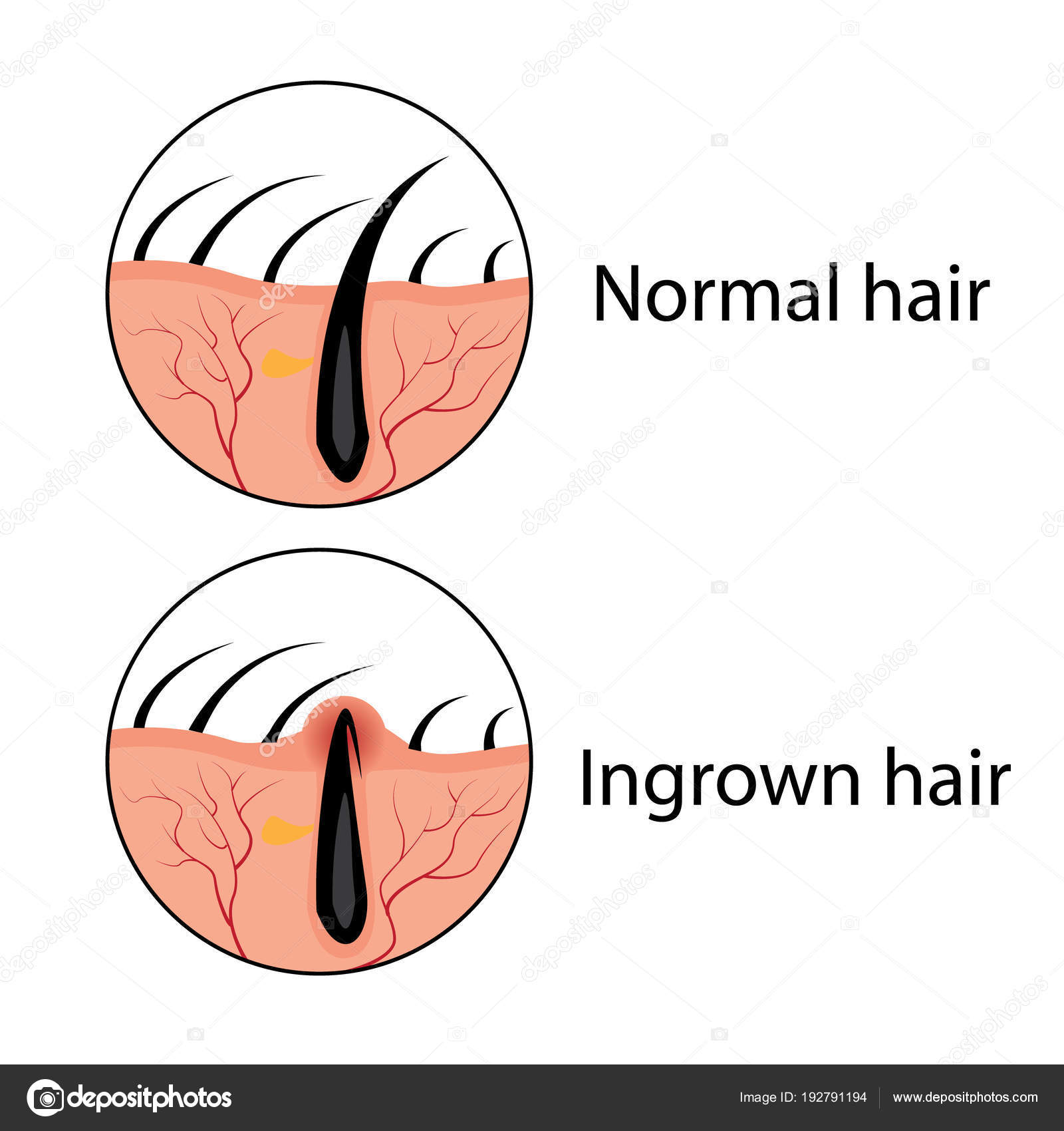 Wait until the inflammation subsides and, if possible, remove the hair. But it is better, of course, to go to a specialist.
Wait until the inflammation subsides and, if possible, remove the hair. But it is better, of course, to go to a specialist.
Kristina Schlega : If you see edema, or a purulent element has grown in size and hurts, you should contact a dermatologist, cosmetologist or surgeon.
Where to go to have an ingrown hair removed?
You can go to a salon with a medical license, to a clinic for a beautician or surgeon.
Kristina Schlega : It is safer to have your hair removed in a salon or medical center than at home. We have laser hair removal machines in our clinic – with their help you can get an ingrown hair.
What can I do to prevent ingrown hairs?
Avoid tight synthetic underwear for 3-5 days after depilation. Wear non-constricting cotton underwear and clothing, through which the skin will breathe – there is less risk of creating a pathogenic environment for bacteria.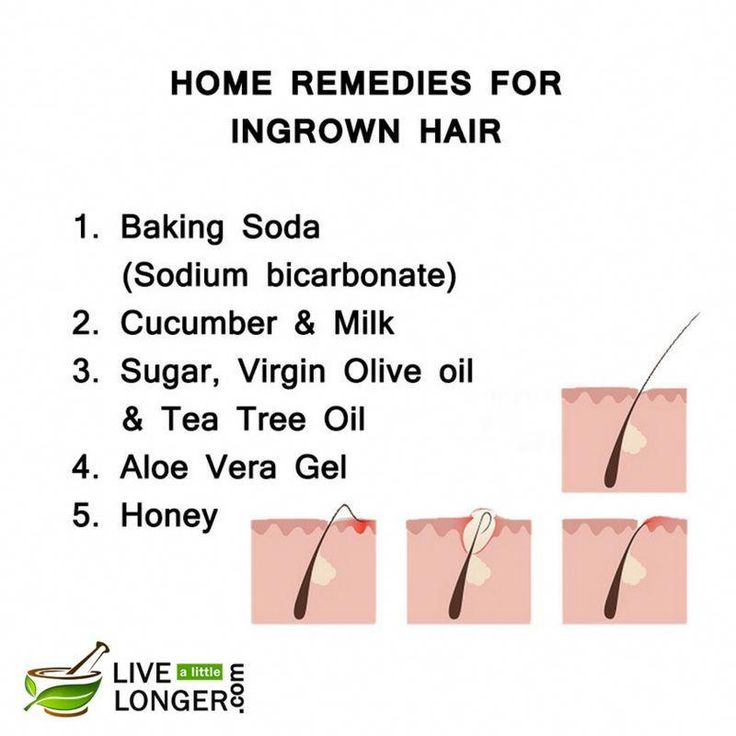
Shave properly.
Shave with sharp razors with special products (foams and gels improve glide). Before shaving, do not steam the skin, do not lie in the bathroom for a long time – otherwise you can remove the top layer of skin with a razor or get hurt on the folds. You can do a light peeling or scrub in advance.
Legs: If the hairs are long, start shaving in the direction of hair growth. If short – against growth.
Bikini line: shave straight ahead and then against.
Armpits: can be shaved in different directions, because the hair grows in different directions there.
Kristina Schlega : The main task of such products is to exfoliate and moisturize the skin so that the hair easily breaks through. This is provided by acids (salicylic and fruit acids), plant extracts (chamomile, calendula, aloe).
I don’t have ingrown hair products on hand.
:quality(70)/cloudfront-eu-central-1.images.arcpublishing.com/irishtimes/DJSGUG3ALYVWTV2MK5JUF72X7Y.jpg) What can replace them?
What can replace them?
Kristina Schlega : You can use acid toner, serum, light peel, enzyme facial powder – products with AHA, BHA acids or enzymes. If the product is intended for home care (and not professional care), then the concentration of active substances is optimal.
What if not one hair has grown in, but 20 at once? What does this mean?
What are you from Brazil 🙂 But seriously, there is such a disease – pseudofolliculitis – when a lot of hair grows at once. As a rule, people with thick skin and dense curly hair suffer from it.
Or you have found yourself in the hands of an incompetent epilator.
Our experts:
Kristina Shlega
cosmetologist of the LazerJazz clinic
Irina Zhurina
Wax & Go salon chain master
ingrown hair spots and badyaga, photo
ingrown hair spots …
34 replies
Last —
Go to
#1
It is necessary to scrub, probably, after epilation a few days, then there will be no ingrown hairs. I think so)) 314
I think so)) 314
#4 #50003
Natasha, I scrub my whole body every day, I just have thick, black and wavy hair on my legs – a complete set. I have been using the epilator for many years, and for me, “ingrown hairs” are no longer just hairs that at first cannot be shaved off, and then it becomes clear that they are under the skin. For me, these are huge bumps that sooner or later fill with vile pus and burst, and somewhere there, at a depth of several millimeters, a long hair hid (((((if you don’t pull out the hair, the scar remains much more trenchant than any spots ( (((
#6
#7
90 363 29 April 2011, 23:50
#8
Author
Natasha, I scrub my whole body every day, I just have thick, black and wavy hair on my legs – a complete set. I have been using the epilator for many years, and for me, “ingrown hairs” are no longer just hairs that at first cannot be shaved off, and then it becomes clear that they are under the skin. For me, these are huge bumps that sooner or later fill with vile pus and burst, and somewhere there, at a depth of several millimeters, a long hair hid (((((if you don’t pull out the hair, the scar remains much more trenchant than any spots ( (((
I have been using the epilator for many years, and for me, “ingrown hairs” are no longer just hairs that at first cannot be shaved off, and then it becomes clear that they are under the skin. For me, these are huge bumps that sooner or later fill with vile pus and burst, and somewhere there, at a depth of several millimeters, a long hair hid (((((if you don’t pull out the hair, the scar remains much more trenchant than any spots ( (((
But I don’t smear anything, neither bodyagi, nor peroxide, I just blot it with alcohol
After epilation I smear it with some kind of milk, like Clean Line for the body
#9
#10
#11
Shave against growth – it is pricked at once. Allergy has already gone to the depilatory cream. I live in Florida, walking in pants here is not to love yourself))) Therefore, the way out is to shave according to hair growth (shave for a long time), then with golden oil (the oil itself is yellow + small sparkles), at least disguise. But it doesn’t help the stains.
I live in Florida, walking in pants here is not to love yourself))) Therefore, the way out is to shave according to hair growth (shave for a long time), then with golden oil (the oil itself is yellow + small sparkles), at least disguise. But it doesn’t help the stains.
By the way, the legs don’t look so scary anymore, and the freshest stain (actually, it was a burn from too hot wax) has brightened!
#12
#13
I go for wax + I did it myself with warm wax in a cartridge on my legs … that’s all I did it right, and then I smeared my legs with olive oil to remove the remnants of wax – no irritation.
good luck to you!
#14
#15
It hurts to walk because the skin on my legs hurts 0_0
#16
#17
some strange action))))
#19
– if it’s still at the stage of inflammation – I think it’s useless to smear the scars with brilliant green. after pulling out and squeezing out my hair, I had terrible huge red spots, and they didn’t heal for a long time (and my skin is terribly sensitive). I first smeared with argosulfan – a wound healing ointment, very good, judging by the indications for use. but something didn’t last long anyway. I generally keep quiet about bepanthen – no effect. and anointed with the good old green. Within 2 days the redness was gone. now the paint is still left, but it is clear that the appearance of the legs is already much better. brilliant green, of course, is not the most aesthetic option – you have to walk around in trousers for a week .. but beauty requires sacrifice)
after pulling out and squeezing out my hair, I had terrible huge red spots, and they didn’t heal for a long time (and my skin is terribly sensitive). I first smeared with argosulfan – a wound healing ointment, very good, judging by the indications for use. but something didn’t last long anyway. I generally keep quiet about bepanthen – no effect. and anointed with the good old green. Within 2 days the redness was gone. now the paint is still left, but it is clear that the appearance of the legs is already much better. brilliant green, of course, is not the most aesthetic option – you have to walk around in trousers for a week .. but beauty requires sacrifice)
#20
#21
#22
Experts Woman. en
Julia Lekomtseva
Cosmetologist
280 answers
Sadovnikov Ernest
Psychologist .
 …
…211 answers
Oksana Nosachenko
Psychologist
34 answers
Dmitry Olegovich Surotkin
Psychotherapist
26 answers
Egor Mazurok
Clinical psychologist
20 answers
Oksana Aleksandrovna
Practical psychologist
31 answers
Pankratova Elizaveta
Nutritionist
9 answers
Ivanova Svetlana
Coach
96 answers
Maria Burlakova
Psychologist
383 answers
Julia Karateeva
Development expert.
 ..
..3 answers
#23
Author
Another topic about badyagi. I read old topics, they are very old, in order to dig into them again, so I created a new one. I, like many, have had nightmares of ingrown hairs and ingrown hairs after several years of using the epilator. I couldn’t get badyaga in powder, so yesterday, separately from each other, I anointed my legs with hydrogen peroxide and badyaga forte gel. Today, nothing pricked, I spent the whole day in my pants, took them off, and under them there is such horror. http://s53.radikal.ru/i141/1104/6f/0f3f69adbebd.jpg I have never used badyaga before, please tell me, is this how it should be? Or is it an allergic reaction? The skin is not flaky, just covered with some red pimples. Before the procedure, I didn’t touch my legs for several days, neither with a razor, nor with wax, nothing . ..
..
#25
#26
I bought a Badyaga Forte gel .. I smeared it on my feet, then held 20 minutes …
And there is no effect ((the skin does not blush, does not pinch …
maybe I wiped little?
Unreliable stories
My husband and his children and grandchildren piss me off…
1,726 answers
The man immediately warned that all the property was registered to the children
1,433 answers 9000 3
Such a salary – I don’t want to work
889 answers
A lie 22 years long. How to destroy?
1 113 answers
Husband left, 2 months of depression… How will you cope if you are left all alone?
211 replies
#28
#29
#30
#31
#32
#33
I’m going to go sunbathing soon – then I’ll have to stop all this)
More advice – buy an epilator suitable for epilation in water – from wet skin, the hairs are pulled out more easily and are less likely to break off, and less painful.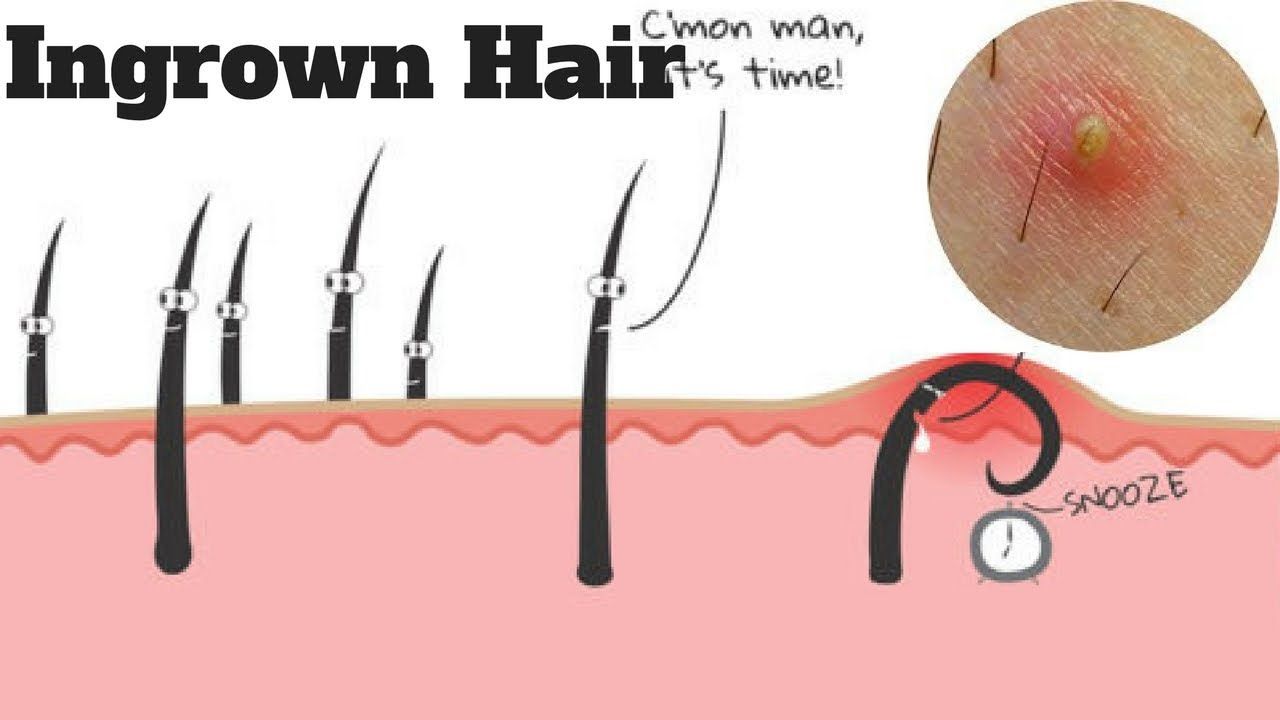
#34
Daria
Julia so you do it right and you won’t burn anything) without peroxide .2 spoons of badyagi 3 water and gently rub for 15 minutes and rinse with warm water)
New topics per day:
Saggy breasts
35 answers
Black unwanted chest hair in girls
1 answer
How to hide shoulder scars
6 answers
Do I have a waist? Photo inside
46 answers
Shaving legs and everything
9 answers
How to wash the navel 90 019
4 answers
dirty women’s heels
10 answers
I am ashamed of my thinness
19 answers
Waist after childbirth.


 It looks like a big pimple or boil. As a rule, it occurs in owners of thick, dense skin.
It looks like a big pimple or boil. As a rule, it occurs in owners of thick, dense skin.
 …
… ..
..